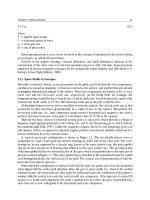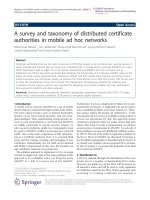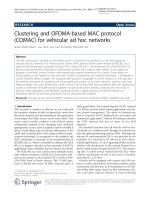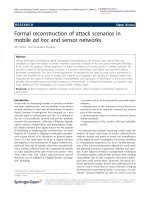Location dependent data caching with handover and replacement for mobile ad hoc networks
Bạn đang xem bản rút gọn của tài liệu. Xem và tải ngay bản đầy đủ của tài liệu tại đây (578.8 KB, 93 trang )
LOCATION-DEPENDENT DATA CACHING
WITH HANDOVER AND REPLACEMENT
FOR MOBILE AD HOC NETWORKS
QIAO YUNHAI
(B.Eng(Hons.), NUS)
A THESIS SUBMITTED
FOR THE DEGREE OF MASTER OF ENGINEERING
DEPARTMENT OF ELECTRICAL AND COMPUTER
ENGINEERING
NATIONAL UNIVERSITY OF SINGAPORE
2006
Acknowledgements
The first thank you should be given to my supervisors Associate Professor Bharadwaj Veeravalli and Professor Lawrence Wong WaiChoong, whose help, stimulating
suggestions and encouragement helped me in all the time of research for and writing of this thesis. They are not only great scientist with deep vision but also and
most importantly kind persons. Their trust and scientific excitement inspired me
in the most important moments of making right decisions and I am glad to work
with them.
I would like to thank Assistant Professor Vikram Srinivasan, whom I am deeply
indebted to. I owe him lots of gratitude for having shown me this way of research.
He could not even realize how much I have learned from him.
I would like to express my sincere appreciation to Miss Xia Li for her invaluable
discussions, suggestions and technical supports on this work.
My thanks also go out to the Department of Electrical and Computer Engineering
for giving me permission to commence this thesis in the first instance, to do the
necessary research work and to use all kind of resources for my research.
ii
Acknowledgements
iii
I feel a deep sense of gratitude for my parents who formed part of my vision and
taught me the good things that really matter in life. I wish to thank my beloved
girlfriend for her love and patience during the past 10 years.
Finally, I would like to express my gratitude to all the others who gave me the
possibility to complete this thesis.
Qiao Yunhai
January 2006
Contents
Acknowledgements
Summary
ii
vii
List of Tables
ix
List of Figures
x
1 Introduction
1
1.1
Introduction to Ad Hoc Networks . . . . . . . . . . . . . . . . . . .
1
1.1.1
Advantages & Applications of Ad Hoc Networks . . . . . . .
2
1.1.2
Challenges Faced by Ad Hoc Networks . . . . . . . . . . . .
3
1.1.3
Routing Schemes for Ad Hoc Networks . . . . . . . . . . . .
4
1.2
Overview of Data Caching . . . . . . . . . . . . . . . . . . . . . . .
5
1.3
Basic Cache Replacement Policies . . . . . . . . . . . . . . . . . . .
8
1.4
Motivation of This Thesis . . . . . . . . . . . . . . . . . . . . . . .
8
iv
Contents
1.5
v
Thesis Organization . . . . . . . . . . . . . . . . . . . . . . . . . . .
2 Contributions & Problem Formulation
11
12
2.1
The Problem . . . . . . . . . . . . . . . . . . . . . . . . . . . . . .
12
2.2
Problem Formulation . . . . . . . . . . . . . . . . . . . . . . . . . .
14
2.3
Complexity Analysis . . . . . . . . . . . . . . . . . . . . . . . . . .
15
2.4
Data Access Models . . . . . . . . . . . . . . . . . . . . . . . . . . .
18
2.5
Assumptions & Properties . . . . . . . . . . . . . . . . . . . . . . .
20
3 Data Caching with & without Handover and Replacement
3.1
22
Proposed Data Caching Schemes . . . . . . . . . . . . . . . . . . .
22
3.1.1
Selfish Cache Scheme . . . . . . . . . . . . . . . . . . . . . .
22
3.1.2
Simple Cache (SC) Scheme . . . . . . . . . . . . . . . . . . .
23
3.1.3
Relay Cache (RC) Scheme . . . . . . . . . . . . . . . . . . .
23
3.2
Location-Dependent Cache Handover Policy . . . . . . . . . . . . .
26
3.3
Location-Dependent Cache Replacement Policy . . . . . . . . . . .
28
4 Mobility Models
30
4.1
Random Waypoint . . . . . . . . . . . . . . . . . . . . . . . . . . .
30
4.2
Random Direction . . . . . . . . . . . . . . . . . . . . . . . . . . .
32
4.3
Gauss-Markov . . . . . . . . . . . . . . . . . . . . . . . . . . . . . .
35
4.4
Manhattan Grid . . . . . . . . . . . . . . . . . . . . . . . . . . . . .
36
4.5
Reference Point Group Mobility (RPGM) . . . . . . . . . . . . . . .
37
4.6
Discussions of Mobility Models . . . . . . . . . . . . . . . . . . . .
40
5 Performance Evaluation
5.1
Simulation Model and system parameters . . . . . . . . . . . . . . .
42
42
Contents
vi
5.2
Performance Metrics . . . . . . . . . . . . . . . . . . . . . . . . . .
47
5.3
Results and Discussions . . . . . . . . . . . . . . . . . . . . . . . .
49
5.3.1
Tuning Hi & Γ . . . . . . . . . . . . . . . . . . . . . . . . .
49
5.3.2
Effects of Giving Priority to Smaller Size File . . . . . . . .
52
5.3.3
Results for Random Mobility Models . . . . . . . . . . . . .
53
5.3.4
Results for Manhattan Grid Mobility Model . . . . . . . . .
60
5.3.5
Results for RPGM Mobility Model . . . . . . . . . . . . . .
64
6 Conclusions
70
Bibliography
73
Summary
Over the last few years, the field of wireless ad hoc networks has attracted tremendous interest from the research community. The primary attraction of a wireless
ad hoc network is the fact that networks can form spontaneously without the
need for any fixed infrastructure. The critical design issues for mobile ad hoc
networks include provisioning of seamless communication with Quality-of-Service
(QoS) guarantees, high data accessibility, reliable data transfer, low energy consumption, and high communication performance. However, limited bandwidth
and battery power, mobility of nodes, and frequent change of network topology
add several new dimensions to this problem.
Due to the mobility characteristic of a mobile ad hoc network, many routing techniques have been developed to route messages. Although routing protocols play
an important role in mobile ad hoc networks, other issues such as data access are
also important to achieve the ultimate goal of setting up a network, which is to
communicate with each other and exchange information. Since wireless resources
in a mobile ad hoc network are rather limited, data requests must be satisfied in
a very efficient way. Usually those data requests, that cannot be satisfied within a
vii
Summary
period of time, are considered as failed/blocked. Therefore, it is a challenging task
to retain data accessibility over a mobile ad hoc network. The overall objective
of this research is to design and develop data caching schemes in order to retain
data accessibility. In particular, a single-server network model is considered and a
location-dependent data access pattern is addressed. A selfish cache technique is
introduced as the underlying reference. Two caching schemes are proposed, Simple Cache and Relay Cache. Location-dependent cache handover and replacement
schemes are introduced to further enhance data accessibility.
Most of previous works use Random Waypoint Mobility Model, which is not realistic enough in most situations. In order to verify the performance of the proposed
schemes and to recommend the most relevant caching policy in different cases, various mobility models are examined in this research, including Random Waypoint,
Random Direction, Gauss-Markov, Manhattan Grid and Reference Point Group
Mobility (RPGM).
The performance is evaluated by examining the impact of memory size, request
generating time, and the maximum moving speed of mobile nodes on data accessibility. Furthermore, energy consumption is considered in this research. Hence, a
reasonable recommendation could be made by balancing energy consumption and
data accessibility.
viii
List of Tables
1.1
Routing Protocols . . . . . . . . . . . . . . . . . . . . . . . . . . . .
5
5.1
Global Simulation Parameters . . . . . . . . . . . . . . . . . . . . .
45
5.2
Specific Simulation Parameters for different mobility models . . . .
46
ix
List of Figures
1.1
A Mobile Ad Hoc Network . . . . . . . . . . . . . . . . . . . . . . .
2
2.1
Topology Change in Ad Hoc Networks . . . . . . . . . . . . . . . .
12
2.2
Example of Data Caching . . . . . . . . . . . . . . . . . . . . . . .
16
2.3
Data Access Models . . . . . . . . . . . . . . . . . . . . . . . . . . .
19
3.1
Relay Cache Example . . . . . . . . . . . . . . . . . . . . . . . . . .
23
4.1
Random Mobility Model . . . . . . . . . . . . . . . . . . . . . . . .
31
4.2
Example of Random Waypoint Mobility Models . . . . . . . . . . .
32
4.3
Example of Random Direction Mobility Models . . . . . . . . . . .
33
4.4
Example of Manhattan Grid Mobility Models . . . . . . . . . . . .
36
4.5
RPGM Mobility Models . . . . . . . . . . . . . . . . . . . . . . . .
38
4.6
Example of RPGM Mobility Model . . . . . . . . . . . . . . . . . .
39
5.1
Event Generation Process . . . . . . . . . . . . . . . . . . . . . . .
48
5.2
Data Blocking Ratio vs. Gamma (Γ) . . . . . . . . . . . . . . . . .
50
x
List of Figures
5.3
xi
Data Blocking Ratio vs. Memory Size (Effects of Giving Priority to
Smaller Size File) . . . . . . . . . . . . . . . . . . . . . . . . . . . .
53
5.4
Data Blocking Ratio vs. Memory Size (Random Waypoint) . . . . .
54
5.5
Data Blocking Ratio vs. Request Generating Time (Sec) (Random
Waypoint) . . . . . . . . . . . . . . . . . . . . . . . . . . . . . . . .
55
5.6
Data Blocking Ratio vs. Vmax (m/s) (Random Waypoint) . . . . .
57
5.7
Total Energy Consumption vs. Vmax (m/s) (Random Waypoint) .
58
5.8
Data Blocking Ratio vs. Memory Size (Manhattan Grid) . . . . . .
61
5.9
Data Blocking Ratio vs. Request Generating Time (Sec) (Manhattan Grid) . . . . . . . . . . . . . . . . . . . . . . . . . . . . . . . .
62
5.10 Data Blocking Ratio vs. Vmax (m/s) (Manhattan Grid) . . . . . .
63
5.11 Total Energy Consumption vs. Vmax (m/s) (Manhattan Grid) . . .
63
5.12 Data Blocking Ratio vs. Memory Size (RPGM) . . . . . . . . . . .
65
5.13 Data Blocking Ratio vs. Request Generating Time (Sec) (RPGM) .
66
5.14 Data Blocking Ratio vs. Vmax (m/s) (RPGM) . . . . . . . . . . .
68
5.15 Total Energy Consumption vs. Vmax (m/s) (RPGM) . . . . . . . .
68
Chapter
1
Introduction
1.1
Introduction to Ad Hoc Networks
The last decade has seen the rapid convergence of two pervasive technologies:
wireless communication and the Internet [1]. Today, many people carry numerous
portable devices, such as laptops, mobile phones, PDAs and iPods or other mp3
players, for use in their professional and private lives. As a result, people may store
their data in different devices according to their own preferences. Most of the time,
it is very difficult to exchange data between different types of devices without the
aid of a network. Furthermore, it is not always possible to make use of the Internet
as their underlying networking platform due to physical/geographical constraints.
With the development of technology in wireless communication, more and more
mobile devices are integrated with wireless communication capacity. Therefore, a
technique allowing a group of mobile devices to build a network among themselves
anytime and anywhere becomes interesting to the research community.
Mobile ad hoc network is the outcome of this demand as mentioned before. Basically, a mobile ad hoc network is an autonomous collection of mobile nodes [2].
1
1.1 Introduction to Ad Hoc Networks
N6
N4
N5
N3
N2
N0
N1
Figure 1.1: A Mobile Ad Hoc Network
Mobile nodes can communicate with each other by creating a multi-hop wireless
connection and maintaining connectivity without any special infrastructure. Each
mobile node plays the role of a router which handles the communications among
mobile nodes. A mobile node can communicate with another node that is immediately within its radio range. If a node outside its radio range need to be accessed,
one or more intermediate nodes will be needed to relay the data between the source
and the destination. Figure 1.1 shows an example of a typical mobile ad hoc network. In this example, N4 can communicate with N5 and N3 directly as they are
located within the transmission range of N4. However, N0 is outside of the radio
range of N6, intermediate nodes N1, N2, N3, N4 and N5 then act as routers while
establishing the connection between N0 and N6.
1.1.1
Advantages & Applications of Ad Hoc Networks
The major advantage of a mobile ad hoc network is that it does not need any base
station as is required in either wired network or regular mobile networks, such as
2
1.1 Introduction to Ad Hoc Networks
GSM, GPRS or even 3G [2]. With further advances in technology, mobile ad hoc
networks will be implemented in various situations. A mobile ad hoc network can
be formed in any place as required immediately which makes it indispensable in
battlefield and disaster relief/rescue situations. It is useful in some places that
are not covered by fixed network with Internet connectivity. In this situation,
the mobile nodes in the newly established ad hoc network can be used to provide
the coverage. It also can be used in areas where the available network has been
destroyed. As mobile devices are driven by battery, mobile ad hoc networks can
be used in the situation of electricity failure, which lead the traditional Internet or
cellular network out of order because they are both dependent on the line power.
1.1.2
Challenges Faced by Ad Hoc Networks
As any conventional wired/wireless network, there are some common challenges
that need to be faced while setting up a new mobile ad hoc network. Similar to
other wireless networks, the boundaries of the network are not well defined and
hence it is possible for any node to enter and leave the network at any time while
they are moving. It is also possible for a mobile ad hoc network with a large
number of nodes to split into two or more networks either because these groups
are physically apart from one another or due to disfunction of some key joint mobile
nodes. Hidden-terminal and exposed-terminal problems are also faced by mobile
ad hoc networks. In a mobile ad hoc network, mobile nodes have both power and
bandwidth constraints, which will lead to power failure or channel congestions and
both will decrease the QoS of the mobile ad hoc network. Furthermore, a mobile
ad hoc network may be constructed by all kinds of mobile devices, which may
have different capacity, functionality and protocols. Hence it is necessary to find a
solution where all these devices can operate together.
3
1.1 Introduction to Ad Hoc Networks
1.1.3
Routing Schemes for Ad Hoc Networks
Both the advantages and the challenges of mobile ad hoc networks are due to the
mobility of nodes, which makes the network topology change frequently. Therefore,
routing in such networks is an important issue and meanwhile is a challenging task.
Because of the importance of routing in mobile ad hoc networks, a lot of research
have been done on this topic and many routing schemes have been proposed. Most
of the proposed routing schemes use the information about the links that exist in
the network to perform data forwarding. Those routing protocols can be roughly
divided into three categories: proactive (table-driven), reactive (on-demand) and
hybrid.
1. Proactive routing algorithms employ classical routing schemes such as distancevector routing or link-state routing. They maintain routing information
about the available paths in the network even if these paths are not currently used.
2. Reactive routing protocols maintain only the routes that are currently in use,
thereby reducing the burden on the network when only a small subset of all
available routes is in use at any time.
3. Hybrid routing protocols combine local proactive routing and global reactive
routing in order to achieve a higher level of efficiency and scalability.
Examples of routing protocols belonging to these three categories are shown in
Table 1.1 respectively. Several more sophisticated routing protocols have been
proposed by employing route caching schemes [15, 16].
4
1.2 Overview of Data Caching
Table 1.1: Routing Protocols
1. Destination Sequenced Distance Vector (DSDV) [8]
2. Fisheye State Routing (FSR) [5]
3. Optimized Link State Routing Protocol (OLSR) [6]
Proactive 4. Source Tree Adaptive Routing (STAR) [4]
5. Topology Dissemination Based on Reverse-Path
Forwarding (TBRPF) [3]
6. Wireless Routing Protocol (WRP) [7]
7. Associativity Based Routing Protocol (ABR) [9]
8. Ad Hoc on Demand Distance Vector Routing
Reactive
(AODV)[12]
9. Dynamic Source Routing (DSR) [11]
10. Temporary Ordered Routing Algorithm (TORA) [10]
Hybrid
1.2
11. Zone Routing Protocol (ZRP)[13]
Overview of Data Caching
In traditional wired networks, the network topology seldom changes once the network is set up properly. The servers usually have very high computation capacity
and storage space, which allow them to implement complicated algorithms to serve
various applications in the network. On the other hand, the bandwidth and other
resources are abundant, which ensure that data requests are not to be blocked due
to lack of resources within a short period of time. However, in mobile ad hoc networks, disconnection and network division occur frequently as mobile nodes move
arbitrarily, and the wireless resources are very sparse. As a result, data request
may be easily blocked when no route exist between requesting node and the data
5
1.2 Overview of Data Caching
6
server or when the wireless bandwidth is used up. Thus, data accessibility in mobile ad hoc networks is lower than in the conventional wired networks, where the
data accessibility is defined as the ratio of successfully served data requests, Rsuc ,
over all data requests in a network, Rtot , as shown by the equation below:
Pa =
Rsuc
Rtot
(1.1)
Caching was first introduced by Wilkes [17] in 1965, and is popularly employed in
many systems, such as distributed file systems, database systems, and traditional
wired network systems, etc.
In the past few decades, data caching has been widely studied and used in distributed file systems and traditional wired networks [19, 20, 21, 22, 23, 24, 33, 34].
In such systems, nodes that host the database are more reliable and system failures
do not occur as frequently as in mobile ad hoc networks. Therefore, it is usually
sufficient to create a few replicas of a database, which can be used to provide higher
accessibility.
Data caching has been extensively studied in a Web environment as well [30, 31].
The goal is to place some replicas of web servers among a number of possible
locations so that the query delay is minimized. In the Web environment, links
and nodes are stable. Therefore, the performance is measured by the query delay,
and data accessibility is not a big issue. Energy and memory constraints are not
considered either.
Hara [38] proposed some replica allocating methods to improve data accessibility
on mobile ad hoc networks by replicating the original data and distributing the
replicas over the network beforehand. Those methods assume that all mobile nodes
are aware of the overall access probabilities to every data item in the network and
the access pattern is static throughout the life of the network.
1.2 Overview of Data Caching
Another group of researchers addressed the cached data discovery problems. Takaaki
[39] proposed a “self-resolver” paradigm as a cached data discovery method in his
paper, which took into account the stability of a multi-hop route and derived two
types of link model: neighbor-dependent link model and neighbor-independent link
model. Instead of developing a complicated caching algorithm, Lim [40] integrated
a simple search algorithm into an aggregated caching scheme so as to access the
cached data more effectively. Yin and Cao [25] proposed a set of cooperativecaching algorithms, CachePath and CacheData. In CachePath, the path to each
cached data item is stored and the cached data path will be used to redirect further
requests to nearby caching nodes. CacheData allows multiple nodes to cache the
data along the path established between the requesting node and the data server.
There are several advantages of using data caching:
1. Data caching reduces bandwidth consumption, thereby decreasing network
traffic and lessens network congestion.
2. Data caching reduces access latency due to two reasons:
(a) Frequently accessed data are fetched from nearby caching nodes instead
of faraway data servers, thus the transmission delay is minimized.
(b) Because of the reduction in network traffic, those data not cached can
also be retrieved relatively faster than without caching due to less congestion along the path and less workload at the server.
3. Data caching reduces the workload of the data server by disseminating data
among the mobile nodes over the ad hoc network.
4. If the data server is not available due to physical failure of the server or
network partitioning, the requesting node can obtain a cached copy at the
caching nodes. Thus, data accessibility is enhanced.
7
1.3 Basic Cache Replacement Policies
5. Data caching reduces the battery energy consumption as some requests are
served either locally or by some nearby caching nodes.
1.3
Basic Cache Replacement Policies
The objective of cache replacement algorithms is to minimize the miss count in
finite-sized storage systems. Some of the cache replacement policies have been
studied for Web caching [41, 42]. A replacement policy can be generally defined by
a comparison rule that compares two cached items. Once such a rule is known, all
objects in the cache can be sorted in an increasing order, and this is sufficient to
apply a replacement policy: the cache will remove the object of lowest value with
respect to the given comparison rule. Each cached item has several attributes, such
as access time (the last time when the object was accessed), item size or access
frequency. These attributes are used to define the replacement policies. Least
Recently Used (LRU)[36], Least Frequently Used (LFU)[36] and Minimum Size
(MINS)[37] are three such policies.
1.4
Motivation of This Thesis
Because of the amount of efforts have been put by the researchers over the years,
nowadays, the routing protocols for mobile ad hoc networks are more mature than
any other research topic in the area of mobile ad hoc networks. With the currently
available routing schemes, it is not difficult to establish effective routes between
sources and destinations in a mobile ad hoc network. However, the ultimate goal
of setting up a mobile ad hoc network is not to establish routes, but to provide a means to accomplish information exchange. Therefore, besides developing
high-performance routing protocols, more efforts should be put in improving data
8
1.4 Motivation of This Thesis
accessibility among mobile nodes in mobile ad hoc networks. In order to address
this objective, the idea of data caching is employed in mobile ad hoc networks,
whereby intermediate nodes hold the data requested by other nodes in their cache
memories and those cached data will be used to serve further requests generated
among mobile nodes in the network.
So far in the literature there is little attention devoted to the study of caching
schemes with location-dependent data access being taken into account. Data
caching schemes with location-dependent data replacement and data handover policies are even rarer. However, the scenario is common that nodes have similar sets
of desired data while they are traveling in the same location. For example, people
are more likely to ask for information about animals/birds when they are visiting
a zoo, but people who are shopping at a downtown area hardly have the interests
to know anything about a tiger or a fox. Therefore, the type of information people access is related to their location, in this thesis, we call it location-dependent
data access pattern. On the other hand, as mobile nodes only have limited storage
space, it is impossible for one node to hold all the data available in the network due
to these physical limitations. Due to the limited bandwidth and energy, it is also
not a good idea to have all requests served by the data server because the wireless
channels will be very congested near the data server and those mobile nodes close
to the data server have to consume their energy to relay data for others, which
makes it easy for them to drain out their batteries and the whole network will be
affected. However, if any mobile node could contribute part of its memory space
to hold data for others, the whole network will benefit from its contributions.
However, when a node only holds part of the data, there will be a tradeoff between
the query delay (which may be in terms of hops to traverse or time to spend) and
data accessibility. For example, in a mobile ad hoc network, a node caches the
9
1.4 Motivation of This Thesis
received data in its own memory whenever its request is successfully served. As a
result, the cached data are mainly for its own benefit, and the query delay may be
reduced dramatically since most of requests will be served locally with zero or very
small delay. However, when the location-dependent access pattern is considered,
mobile nodes in the same location will request for a similar set of data, which will
end up with an extreme scenario, that is every mobile node caches similar data
locally, and the rest of the data are not cached by anyone. Therefore, if a node
suddenly requests data, which is not cached by anyone nearby, the request will be
relayed to the data server. The probability to have the request successfully served
by the data server far away from the requesting node is much lower than the success
probability if a node nearby has the data in its memory. In this scenario, in order
to increase data accessibility, neighboring nodes should avoid caching too many
copies of same data by some means (For example, by disallowing caching the same
data that neighboring nodes already have). However, this solution may increase
the hops needed to travel in order to fetch the data since some nodes may not be
able to cache the most frequently accessed data locally, and have to access it from
other caching nodes or data server. Traversing more hops will end up with longer
query delay and higher energy consumption.
In this thesis, we focus on enhancing data accessibility. A location-dependent data
access pattern is studied. Several data caching schemes are proposed to address
data accessibility. The impact on the energy consumption will be considered with
the various data caching protocols employed. Location-dependent data handover
and data replacement techniques are introduced to further improve performance.
Research on mobile ad hoc networks are mostly simulation-based. NS-2 [61] and
Glomosim [62] are the two most popularly used simulators. With the lack of mobility model support, many researchers adopt the Random Waypoint mobility model
10
1.5 Thesis Organization
[50] as their underlying mobility model in most of their simulation experiments.
However, mobility is the most important characteristic for mobile ad hoc networks.
Therefore, in order to evaluate the performance of our proposed caching schemes
under different mobility models, different sets of simulation experiments have been
done over a network with different mobility models, such as the Gauss-Markov mobility model, the Manhattan Grid mobility model and the Group mobility model.
1.5
Thesis Organization
The remainder of this thesis is organized as follows. In Chapter 2, we introduce
the required notations, definitions, and formulate the problem. In Chapter 3, we
present the proposed data caching schemes, then the location-dependent handover
and replacement policies are introduced. In Chapter 4, various mobility models
are presented. In Chapter 5, the detailed simulation testbed is described, then
the experimental results are presented and discussions are made for the results.
Finally, Chapter 6 concludes this thesis and discusses future works.
11
Chapter
2
Contributions & Problem Formulation
In this chapter, we shall introduce the problem we target to solve in this thesis.
The required notations, definitions and terminologies that will be used throughout
this thesis will be presented.
2.1
The Problem
N3
N3
N4
N2
N4
N2
N5
N5
N1
N1
Figure 2.1: Topology Change in Ad Hoc Networks
In wireless ad hoc networks, network disconnections are common because of the
movements and the drain of limited battery resources in mobile devices, which
make it difficult to retain data accessibility. Furthermore, the data traverses many
12
2.1 The Problem
hops from source to destination, which could result in a very large access latency.
Figure 2.1 shows such an example: initially, node N1 and N5 have a direct link
between them. When N5 moves out of N1’s radio range, the link between them is
broken. However, they can still communicate with each other through the intermediate nodes N2, N3, and N4. As a result, after the location change of N5, data has
to travel through 4 hops (N1-N2-N3-N4-N5) to serve a single request generated by
N5 (assuming N1 is the source); in contrast, the data need to traverse only one hop
before the link broke. If N4 and N5 keep generating data requests with a small time
interval between 2 requests, since bandwidth is a scarce and expensive resource in
mobile ad hoc networks, congestion may occur at the links from N1 to N4. In a
more serious case, if the link between N2 and N3 is also broken, the network will
be divided into two partitions. Then, the requests for data by N1 from N3, N4
and N5 will all be blocked because no routes are able to be established to make
the communication successful.
From the example described in the previous paragraph, it is apparent that there
are several difficulties we may encounter while designing a mobile ad hoc network.
These difficulties are network disconnections due to mobility of nodes, channel
congestions near the data source because of high demand of the data and limited
wireless resources, long transmission delay and high energy consumption caused
by multiple hop communication, etc. To address these problems, data caching is
a very effective technique. Assume that N4 keeps a copy of the data in its local
cache memory after receiving it from N1, then this cached data could be used to
serve requests generated by both itself and nearby mobile nodes (e.g. N3,N5). If
N5 migrates out of N1’s radio range, it is able to fetch data from N4 within one
hop instead of fetching it from N1, that is 4 hops away. The transmission delay is
reduced and channel usage is also saved. In the case of a link break between N2 and
N3, although the network is divided and N3, N4 and N5 are not able to get data
13
2.2 Problem Formulation
from N1 directly, their requests would be served by N4. Hence data accessibility
is retained.
2.2
Problem Formulation
The following notations are used in this thesis.
• n: the total number of mobile nodes.
• Ni : mobile node i.
• M : the total number of data items available in the network.
• Di : data item i.
• si : the size of Di .
• Ci : the cache memory size of Ni .
• fij : the link failure probability between Ni and Nj .
• t: the time if a request cannot be served within which it will be considered
as blocked.
• Pb : the data blocking ratio.
Consider an ad hoc network with n mobile nodes, N1 , N2 , ..., Nn with M data items,
D1 , D2 , ..., DM , available in the network. At any given time, the link between Ni
and Nj has a probability of fij to fail, which indicates the disconnection of the
network. In this thesis, fij is equal to fji since only symmetric link is considered.
The link failure is caused only by physical partition of two mobile nodes, which
means there is no route found between them. Furthermore, all requests generated
when link failure occurs will be considered as blocked. For data access, there is no
14









